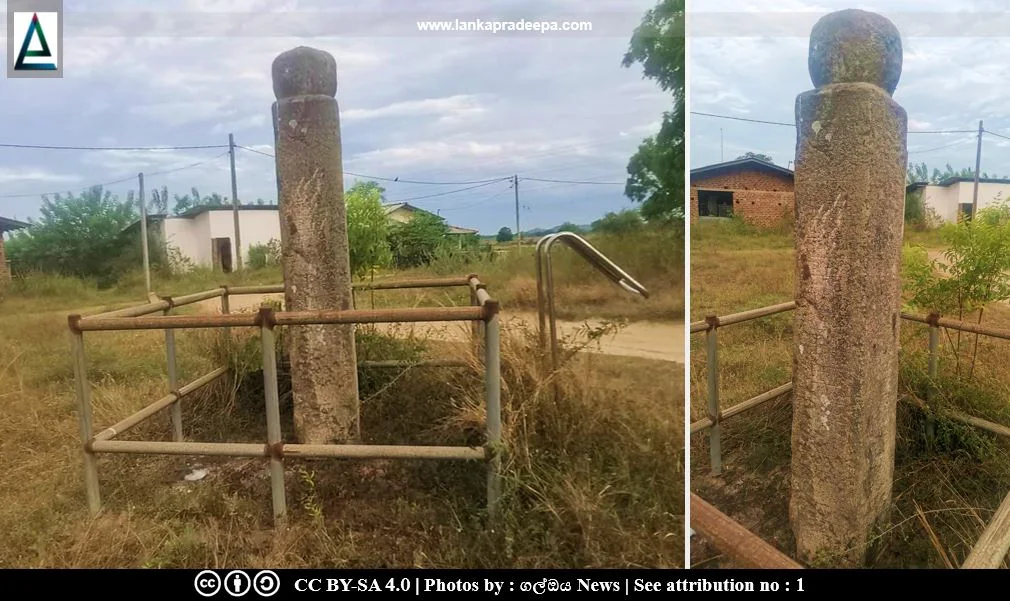
Udayapura Pillar Inscription (Sinhala: උදයපුර ටැම් ලිපිය) is a lithic record discovered in Udayapura village in Ampara District, Sri Lanka. Presently, it stands about 400 m east of the 40th milepost on the Ampara-Sammanturai road.
The pillar
The pillar was discovered in 1961 by the Department of Archaeology at the location where it presently stands (Ranawella, 2004). It is a rectangular stone pillar about 1 ft. wide, 1 ft. long and 5 ft. 11 inches tall and the inscription has been engraved on all four faces of the pillar (Ranawella, 2004). The first two faces have 27 lines of writing each while the third and fourth faces have 25 lines and 5 lines respectively (Ranawella, 2004). The figures of a monk's fan, a cobra, a dog, and a crow are found just below the last line of the fourth face (Ranawella, 2004).
Content
The language and the script of the Udayapura record are Sinhala of the second half of the 10th century A.D. (Ranawella, 2004). It has been engraved in the fifth regnal year of a king styled Sirisangbo Maharad who, according to scholars, is non-other than King Udaya IV [(946-954 A.D.) Ranawella, 2004]. The purport of the record was to register the grant of certain immunities in respect of a village named Munderalagama attached to a monastery named Nilgalu Vehera situated in Metera-Digamadulla, the area around Gal-Oya (Ranawella, 2004). The name "Metera-Digamadulla" has also been found recorded in the Konduwatuwana Pillar Inscription of King Dappula IV (924-935 A.D.), which was discovered in the same region (Ranawella, 2004).
Udayapura Pillar Inscription
Reign: Udaya IV (946-954 A.D.) Period: 10th century A.D.
Script: Medieval Sinhala Language: Medieval Sinhala
Script: Medieval Sinhala Language: Medieval Sinhala
Content: Established by the officers of King Udaya IV in his 5th regnal year on the 10th day of the waxing moon in the month of Il (October-November), this Attani pillar records certain privileges granted to the village Munderalagama attached to Nilgalu Vehera in Metera-Digamadulla. It further mentions that either royal officers on official duty or cattle, buffaloes, domesticated tusk-less elephants shouldn't be permitted to enter this village. Also, beating or sounding drums are prohibited within the boundaries.
Reference: The information board at the site by the Department of Archaeology and the Ministry of Housing, Construction and Cultural Affairs.
Reference: The information board at the site by the Department of Archaeology and the Ministry of Housing, Construction and Cultural Affairs.
As revealed by chronicles, a temple named Nilagalla Vihara has been constructed by King Udaya I [(797-801 A.D.) Nicholas, 1963]. It is believed that this temple was near the place where the Udayapura inscription is located (Ranawella, 2004).
A protected monument
The Udayapura pillar inscription with archaeological evidence in the surrounding area (latitude 07º 17' 35.8'' N and longitude 081º 42' 04.5''E), rocks (with chisel holing) and the place where pieces of ancient pottery are scattered at the place called Pansalwatta belonging to Mihindupura village situated in Grama Niladhari Division No. W/89/N, Mihindupura in the Divisional Secretary’s Division Ampara are archaeological protected monuments, declared by a government gazette
notification published on 10 October 2014. Attribution
1) LankaPradeepa.com would like to thank ගල්ඔය News for providing the necessary photographs required for this article. All the photos are published here with the permission of the author.
References
1) Nicholas, C. W., 1963. Historical topography of ancient and medieval
Ceylon. Journal of the Ceylon Branch of the Royal Asiatic Society, New
Series (Vol VI). Special Number: Colombo. Royal Asiatic Society (Ceylon
Branch). p.37.
2) Ranawella, G.S., 2004. Inscription of Ceylon. Volume V, Part II. Department of Archaeology. pp.213-217.
3) The Gazette of the Democratic Socialist Republic of Sri Lanka. No: 1884. 10 October 2014. p.921.
Location Map
This page was last updated on 4 June 2022
For a complete tourist map follow this link: Lankapradeepa Tourist Map
For a complete tourist map follow this link: Lankapradeepa Tourist Map

